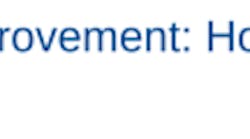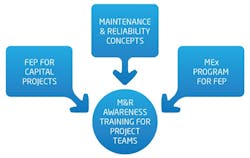Your organization has a goal: Make new assets more reliable by design. To do that, you’re working to build reliability into the design and planning process so that operators, maintenance teams, and all other stakeholders get what they need from a given asset.
In January, we described how to create a request for proposal (RFP) that lays out precisely what you’re looking for from suppliers and exactly the type of partnership you expect from fellow internal stakeholder teams. (Read "Design for reliability, part 1: How to help OEMs help you") Now we turn to the next big questions: How do you get what you need from your vendor partner, and how do you establish the processes that will help you achieve a longer, more-productive life for your new assets?
Life cycle cost and maintenance strategy development
After the initial results of your RFP are secured, do the following to determine your lifecycle cost options and develop an appropriate maintenance strategy for the projects’ assets:
- Perform lifecycle cost (LCC) analysis and use it as the basis for procurement activities. In so doing, you’ll encourage the procurement team to include reliable design features on their “must-have” list and discourage the team from making procurement decisions based solely on initial cost
- Have your cross-functional project team complete a risk-based impact/asset criticality assessment to identify the most-critical assets from a product quality and reliability perspective
- Based on the results of the asset criticality and impact assessment, develop a maintenance strategy that incorporates the cross-functional team’s insights on the asset’s operating context and sequence of operations as well as shared perspectives on failure modes
- Create preventive, predictive, and corrective work plans to address failures when they do occur. As part of this, identify the tools and parts that will be necessary to put these plants into action (and make sure they’ll be readily available)
Training and documentation requirements
Core to your project’s success is providing the project teams with training regarding the benefits of front-end planning (FEP) and how to apply these tools with OEMs, suppliers, vendors, and contractors (see Figure 1).
Ensuring that required documentation and training are available in the required format is a frequently overlooked activity. Leveraging the automation already required on a new asset or system can provide a platform for documentation and training via work instructions and videos. Requesting this intellectual property early in the design and concept phase can identify those providers that have already established such a level of integration. In addition, making sure an expert trainer is provided to teach the content to the operators, technicians, integrators and engineers is invaluable. Often a qualification test in both a written and a practical format can ensure that the training is effective. Project managers tend to underestimate the importance of measuring and tracking results of training; this can lead to a lack of ownership by those operating and maintaining the equipment.
Improvements made by the OEM, supplier, vendor, or contractor after an asset has been purchased, installed, and commissioned often address repetitive failures that other facilities have experienced. As such, they should be written into the contract as documentation that will be provided in the future. The following language, or some facsimile of it, can be included in documentation and contractual/warranty requirements:
- Buyer must be advised for the life of the asset when a publicly available modification is available to the design of equipment or systems installed within two weeks of the available modification
- This includes the following examples:
- Changes to design out the failure modes of repeat failures in next-generation equipment
- Any system modifications or redesigns
- Providing all supporting documentation for the revised designs and solutions
- Identifying potential failure modes the new design may introduce and the recommended mitigation strategies
Commissioning and performance criteria
The final stage before turnover is commissioning, verification, and validation. A poorly installed project is just as likely as a poorly designed project to create long-term operating problems and increase lifecycle costs. After you vet the asset and system design to optimize performance and reliability, the asset needs to be installed and tested to ensure it operates to specification. Up to 70% of failures occur during the startup phase (“infant mortality”); these almost always result from design, installation, and/or procedural errors.
Following is guidance for how to hold an OEM or supplier accountable legally and contractually via the agreements in place for the project requirements. The more proactively these tools and specifications are applied, the more likely the OEM and/or supplier will be prepared to deliver supporting results.
- Performance guarantee
- A performance guarantee is a promise made that the equipment lives up to certain calculated performance criteria and expectations or that a product will continue to perform well over a stated time period
- The goal is to define the company’s commitment and extent of future responsibility
- A performance guarantee in the form of a written legal contract should be written to meet a defined technical efficiency
- Vertical startup
- The term vertical startup refers to meeting all objectives for any project or initiative on Day 1. In essence, it means “doing it right the first time.”
- Including a vertical startup clause in the performance guarantee and payment terms demonstrates the importance and value of manufacturing product immediately and to specification
- A vertical startup guarantee should take the form of a written legal contract that defines a technical startup “exponential curve” and schedule
- Warranty
- The warranty period should be measured from the date the equipment is capable of making sellable product at specified performance levels
- Warranty can include parts, labor, travel, and expenses for all equipment
- Service contracts
Buyer must be able to secure service response times (within first year of service from startup of equipment) as follows:
- Online/phone tech support should be available 24/7
- On-site support should be available within 24 hours
- Response to a nonemergency inquiry should be within 24 hours
- Equipment design improvement notification
- This ensures that design improvements made after the equipment is delivered are communicated back to the buyer in a timely fashion
- Equipment design improvement notifications also should be described in the documentation section
- Factory acceptance testing (FAT) - at the vendor’s facility by individual piece of equipment
- The FAT is a combination of verifying individual machine design elements and restart capabilities
- The FAT will be performed through a sequential series of defined protocols for the following aspects for each machine/asset purchased:
- Static inspections
- Dynamic pretesting
- Induced-failure testing (IFT) - the ability to restart from a failed condition
- Site acceptance testing (SAT) - by individual piece of equipment at the purchaser’s site
- The site acceptance testing shall be scheduled by the purchaser within the first few weeks after the start of sellable production
- Vendor shall facilitate the repair, replacement, or adjustment any component of vendor’s equipment failing this portion of the test (unless vendor’s technical representative can demonstrate that failure was a result of improper installation) and repeat the test until the equipment passes
- If vendor’s technical representative identifies errors or omissions in installation practices or if component failure is shown to be the result of improper and/or nonobvious installation error, the purchaser will direct the installer to make corrections at installer’s expense
- The purchaser will provide reasonable quantities of product, packaging materials, and operating personnel to conduct this test
- The vendor’s representative will help the purchaser conduct equipment test runs and will demonstrate how to meet performance targets
- Purchasers should define in detail the minimum OEE requirements they require to conditionally accept a vendor’s system
- End-to-end acceptance testing - conducted after installation
- The purchaser shall schedule end-to-end acceptance testing within a few weeks after installation
- If vendor’s equipment cannot successfully pass the end-to-end acceptance testing, then the vendor shall repair, replace, or adjust any component that is the cause of such failure at vendor’s expense
- If failure to pass the test can’t be traced to a failed component but is more likely the result of a deficiency in design or construction of the equipment, then the vendor shall (at vendor’s expense) modify or replace the equipment (subject to the purchaser’s approval) to bring the equipment into conformance
- If the vendor can demonstrate that nonperformance is the result of other factors on the line outside the control of the vendor’s equipment, the purchaser will direct a decision to either correct the offending factor or accept vendor’s equipment as installed
- The purchaser will provide reasonable quantities of product, packaging materials, and operating personnel to conduct this test
- Operating equipment effectiveness (OEE) – performance criteria
- The system will be required to meet defined OEE criteria, which specify how well a manufacturing unit performs relative to its designed capacity during the periods when it is scheduled to run
- OEE breaks the performance of a manufacturing unit into three separate but measurable components: availability, performance, and quality, and analysis of each component should point to an aspect of the process that can be targeted for improvement
- OEE analysis allows for evaluation according to very specific parameters, such as part number or shift
- It is unlikely that any manufacturing process can run at 100% OEE, although many manufacturers benchmark their industry to set a challenging target; 85% is not uncommon
- Purchasers should define in detail their minimum OEE requirements for conditionally accepting a vendor’s system
- Early failure expectations and requirements
Marie Getsug is a senior consultant for maintenance and reliability services with Commissioning Agents Inc. Contact her at [email protected].
Stephen Holland is global reliability engineer at Abbott Laboratories/Abbott Nutrition. Contact him at [email protected].
You need to communicate that early failure is unacceptable. Hold the OEM, supplier, vendor and/or contractor responsible by requesting the following information and commitments:
- A list of all the consumable parts and spare parts and the guaranteed minimum mean time between failure (MTBF) for each
- A commitment to immediately address any spare or consumable part with a MTBF of less than six months with an acceptable alternative that provides a MTBF guarantee of greater than six months
- A commitment to address the quality and reliability concerns posed by any spare part or consumable part that requires operator or technician attention more than monthly. Alternative solutions should be presented.
Also read: Design for reliability: Breaking the “maintenance standard” threshold.



